Epidermal Growth Factors (EGF): Role in Cell Growth and Wound Healing

What are Epidermal Growth Factors?
Epidermal growth factors (EGFs) are a group of proteins that signal cells to grow, proliferate, or differentiate by interacting with the epidermal growth factor receptors (EGFRs) on the surface of the cell. EGFs play an important role in regulating cell function during normal wound healing, fetal development, sexual maturation, and cell turnover throughout life.
Types of EGFs
There are several types of EGFs that function in similar ways by binding to EGFRs. Some of the main EGFs include:
- Epidermal growth factor (EGF): Originally identified in mice, Epidermal Growth Factors (EGF) stimulates skin cell regeneration. It is produced in many tissues and binds EGFR to influence cell growth, proliferation, and differentiation.
- Transforming growth factor alpha (TGFα): Structurally similar to EGF, TGFα binds EGFR and acts as an autocrine growth factor for many cell types. It is involved in fetal development, wound healing, and other tissue regeneration processes.
- Amphiregulin: Produced by immune cells, keratinocytes, and fibroblasts, amphiregulin acts as an autocrine and paracrine factor to stimulate cell proliferation during wound healing and inflammation.
- Heparin-binding EGF-like growth factor (HB-EGF): Widely expressed in many tissues and involved in processes like wound healing, angiogenesis, and tissue repair by stimulating cell migration, proliferation, and survival.
Role in Wound Healing
EGFs play a crucial role in wound healing through their effects on cell migration, proliferation, and tissue regeneration. Here are some key ways they promote wound healing:
- Chemotaxis: EGFs trigger migration of keratinocytes, fibroblasts, and endothelial cells to the wound site through chemotactic signaling. This facilitates tissue repair.
- Cell proliferation: Once at the wound, EGFs bind EGFRs on keratinocytes and fibroblasts to stimulate their proliferation. This rapidly replaces lost cells during the proliferative phase of healing.
- Angiogenesis: EGFs like HB-EGF induce new blood vessel formation by activating endothelial cell migration and proliferation. This improves blood supply to the healing site.
- Re-epithelialization: Proliferating keratinocytes aided by EGFs are able to resurface the wound much faster, restoring the protective epidermal barrier.
- Extracellular matrix deposition: EGF activation of fibroblasts causes increased collagen synthesis to rebuild the dermal layer.
- Tissue regeneration: The combined effects of cell migration, proliferation and matrix deposition facilitate full functional regeneration of skin tissue over time.
Get More Insights on- Epidermal Growth Factors (EGF)
- Industry
- Art
- Causes
- Crafts
- Dance
- Drinks
- Film
- Fitness
- Food
- Games
- Gardening
- Health
- Home
- Literature
- Music
- Networking
- Other
- Party
- Religion
- Shopping
- Sports
- Theater
- Wellness
- News


